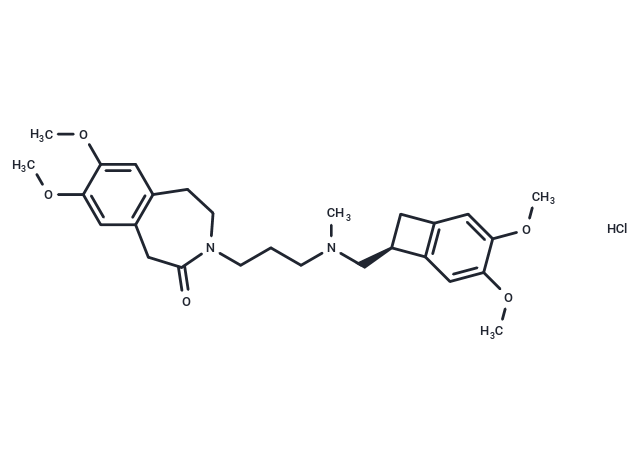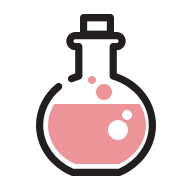- Remove All
 Your shopping cart is currently empty
Your shopping cart is currently empty
Shopping Cart
Ivabradine hydrochloride
Catalog No. T2535Cas No. 148849-67-6
Alias S 16257-2, Ivabradine HCl
Ivabradine hydrochloride (S 16257-2) is a new If inhibitor (IC50: 2.9 μM). Ivabradine Hydrochloride is the hydrochloride salt form of ivabradine, an orally bioavailable, hyperpolarization-activated, cyclic nucleotide-gated (HCN) channel blocker, with negative chronotropic activity. Upon administration, ivabradine selectively binds to the intracellular portion of the HCN channel pore and blocks HCN channels in the pacemaker cells within the sinoatrial (SA) node. This inhibits the If (funny) pacemaker ion current, prevents the inward flow and intracellular accumulation of positively charged ions, reduces pacemaker activity and slows diastolic depolarization.

Ivabradine hydrochloride
Catalog No. T2535Alias S 16257-2, Ivabradine HClCas No. 148849-67-6
Ivabradine hydrochloride (S 16257-2) is a new If inhibitor (IC50: 2.9 μM). Ivabradine Hydrochloride is the hydrochloride salt form of ivabradine, an orally bioavailable, hyperpolarization-activated, cyclic nucleotide-gated (HCN) channel blocker, with negative chronotropic activity. Upon administration, ivabradine selectively binds to the intracellular portion of the HCN channel pore and blocks HCN channels in the pacemaker cells within the sinoatrial (SA) node. This inhibits the If (funny) pacemaker ion current, prevents the inward flow and intracellular accumulation of positively charged ions, reduces pacemaker activity and slows diastolic depolarization.
| Pack Size | Price | Availability | Quantity |
|---|---|---|---|
| 10 mg | $33 | In Stock | |
| 25 mg | $50 | In Stock | |
| 50 mg | $68 | In Stock | |
| 100 mg | $98 | In Stock | |
| 200 mg | $148 | In Stock | |
| 500 mg | $263 | In Stock | |
| 1 mL x 10 mM (in DMSO) | $39 | In Stock |
Bulk & Custom
Add to Cart
Questions
View MoreSelect Batch
Purity:99.73%
Contact us for more batch information
All TargetMol products are for research purposes only and cannot be used for human consumption. We do not provide products or services to individuals. Please comply with the intended use and do not use TargetMol products for any other purpose.Product Introduction
Bioactivity
Chemical Properties
| Description | Ivabradine hydrochloride (S 16257-2) is a new If inhibitor (IC50: 2.9 μM). Ivabradine Hydrochloride is the hydrochloride salt form of ivabradine, an orally bioavailable, hyperpolarization-activated, cyclic nucleotide-gated (HCN) channel blocker, with negative chronotropic activity. Upon administration, ivabradine selectively binds to the intracellular portion of the HCN channel pore and blocks HCN channels in the pacemaker cells within the sinoatrial (SA) node. This inhibits the If (funny) pacemaker ion current, prevents the inward flow and intracellular accumulation of positively charged ions, reduces pacemaker activity and slows diastolic depolarization. |
| Targets&IC50 | If:2.9 μM |
| In vivo | Ivabradine treatment (10 mg/kg/d) induces long-term HRR, and that improves diastolic LV function probably involving attenuated hypoxia, reduced remodeling, and/or preserved nitric oxide bioavailability, resulting from processes triggered early after HRR initiation: angiogenesis and/or preservation of endothelial nitric oxide synthase expression[1]. Ivabradine causes a sustained 15-20% heart rate reduction, but has no effect on blood pressure. While ivabradine has no effect on endothelial function and vascular reactive oxygen species production in angiotensin II-treated rats, it improves both parameters in ApoE knockout mice. Ivabradine treatment leads to an attenuation of angiotensin II signaling and increased the expression of telomere-stabilizing proteins in ApoE knockout mice, which may explain its beneficial effects on the vasculature. The absence of these protective ivabradine effects in angiotensin II-infused rats may relate to the treatment duration or the presence of arterial hypertension[2]. |
| Alias | S 16257-2, Ivabradine HCl |
| Molecular Weight | 505.05 |
| Formula | C27H37ClN2O5 |
| Cas No. | 148849-67-6 |
| Smiles | N1(C(=O)Cc2c(CC1)cc(c(c2)OC)OC)CCCN(C)C[C@@H]1c2c(cc(c(c2)OC)OC)C1.Cl |
| Relative Density. | no data available |
Storage & Solubility Information
| Storage | Powder: -20°C for 3 years | In solvent: -80°C for 1 year | Shipping with blue ice. | |||||||||||||||||||||||||||||||||||
| Solubility Information | DMSO: 93 mg/mL (184.1 mM) Ethanol: 93 mg/mL (184.1 mM) H2O: 75 mg/mL (148.5 mM) | |||||||||||||||||||||||||||||||||||
Solution Preparation Table | ||||||||||||||||||||||||||||||||||||
H2O/DMSO/Ethanol
| ||||||||||||||||||||||||||||||||||||
Calculator
In Vivo Formulation Calculator (Clear solution)
Please enter your animal experiment information in the following box and click Calculate to obtain the mother liquor preparation method and in vivo formula preparation method:
Mother liquor preparation method: 2 mg of drug dissolved in 50 μL DMSO (mother liquor concentration of 40 mg/mL), if you need to configure a concentration that exceeds the solubility of the product, please contact us first.
(mother liquor concentration of 40 mg/mL), if you need to configure a concentration that exceeds the solubility of the product, please contact us first.
Preparation method for in vivo formula: Take 50 μL DMSO main solution, add 300 μLPEG300
main solution, add 300 μLPEG300 mix well and clarify, then add 50 more μL Tween 80, mix well and clarify, then add 600 more μLddH2O
mix well and clarify, then add 50 more μL Tween 80, mix well and clarify, then add 600 more μLddH2O mix well and clarify
mix well and clarify
For Reference Only. Please develop an appropriate dissolution method based on your laboratory animals and route of administration.
Dose Conversion
You can also refer to dose conversion for different animals. More Dose Conversion
Tech Support
Please see Inhibitor Handling Instructions for more frequently ask questions. Topics include: how to prepare stock solutions, how to store products, and cautions on cell-based assays & animal experiments, etc
Keywords
Related Tags: buy Ivabradine hydrochloride | purchase Ivabradine hydrochloride | Ivabradine hydrochloride cost | order Ivabradine hydrochloride | Ivabradine hydrochloride chemical structure | Ivabradine hydrochloride in vivo | Ivabradine hydrochloride formula | Ivabradine hydrochloride molecular weight

Copyright © 2015-2024 TargetMol Chemicals Inc. All Rights Reserved.



